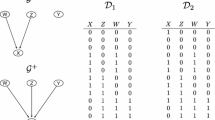Abstract
Stochastic independence is an idealized relationship located at one end of a continuum of values measuring degrees of dependence. Modeling real-world systems, we are often not interested in the distinction between exact independence and any degree of dependence, but between weak ignorable and strong substantial dependence. Good models map significant deviance from independence and neglect approximate independence or dependence weaker than a noise threshold. This intuition is applied to learning the structure of Bayes nets from data. We determine the conditional posterior probabilities of structures given that the degree of dependence at each of their nodes exceeds a critical noise level. Deviance from independence is measured by mutual information. The arc probabilities are set equal to the probability that the mutual information, provided by the neighbors of a node, exceeds a given threshold. A χ2 approximation for the probability density function of mutual information is used. A large number of network structures in which the arc probabilities are evaluated, is generated by stochastic simulation. Finally, the probabilities of the whole graph structures are obtained by combining the individual arc probabilities with the number of possible construction sequences compatible with the partial ordering of the graph. While selecting models with large deviance from independence results in simple networks with few but important links, selecting models with small deviance results in highly connected networks also containing less important links.
Similar content being viewed by others
Explore related subjects
Discover the latest articles and news from researchers in related subjects, suggested using machine learning.Author information
Authors and Affiliations
Rights and permissions
About this article
Cite this article
Kleiter, G. The posterior probability of Bayes nets with strong dependences. Soft Computing 3, 162–173 (1999). https://doi.org/10.1007/s005000050065
Issue Date:
DOI: https://doi.org/10.1007/s005000050065




